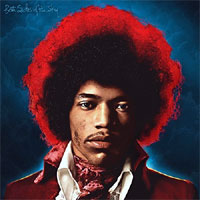Jimi Hendrix • Both Sides of the Sky Experience Hendrix/Legacy 19075 814 201  his is the third of a
trilogy of albums released by the Hendrix estate under the guise of Experience Hendrix,
LLC that includes 2010’s Valleys of Neptune and 2013’s People, Hell
& Angels. These three albums represent the best of Jimi Hendrix’s unreleased
studio recordings, starting with the Jimi Hendrix Experience and continuing through The
Band of Gypsies and sessions he had with friends like Steven Stills, Johnny Winter and
Lonnie Youngblood. That Hendrix was prolific in the studio should not be news to any fan.
By all accounts, he was at his happiest when recording, especially after the opening of
Electric Ladyland Studios. his is the third of a
trilogy of albums released by the Hendrix estate under the guise of Experience Hendrix,
LLC that includes 2010’s Valleys of Neptune and 2013’s People, Hell
& Angels. These three albums represent the best of Jimi Hendrix’s unreleased
studio recordings, starting with the Jimi Hendrix Experience and continuing through The
Band of Gypsies and sessions he had with friends like Steven Stills, Johnny Winter and
Lonnie Youngblood. That Hendrix was prolific in the studio should not be news to any fan.
By all accounts, he was at his happiest when recording, especially after the opening of
Electric Ladyland Studios.
It is surprising, then, that all but one of the tracks on this album were recorded at The Record Plant, and the other was at Olympic Studios. Though mostly blues, this album has Hendrix playing in a variety of styles. The 13 tunes are both classic (like "Hear My Train A Comin'") and contemporary (such as the cover of Joni Mitchell’s "Woodstock" with Steven Stills). The playing times -- from roughly three and a half to over seven minutes -- allowed Hendrix and his bandmates to stretch out and play, and necessitated that Both Sides of the Sky be a double-LP release. As usual, all of these tracks were recorded, engineered and mixed by Eddie Kramer, who was there with Hendrix nearly every step of the way, so the quality of these recordings varies little from the official releases. The best reason to make sure a copy of this album resides in your music collection is hearing Jimi Hendrix play so well with others. "Georgia Blues" features Lonnie Youngblood on lead vocals and organ, as well as the use of a saxophone (unique in the Hendrix canon) besides Hendrix's guitar, along with bass and drums, giving the song an R&B feel. Hearing Jimi Hendrix duel with blues guitar master Johnny Winters is pure, unadulterated fun, but it’s the two tracks with Stills that I enjoyed most. While a guitarist of more than average talent, Stills couldn’t help but be overshadowed by Hendrix, yet I get the feeling that these sessions were a mutual-admiration society. Stills's playing differs enough from Hendrix’s that the distinction is rendered more in service of the music, rather than a chance for Hendrix to demonstrate his guitar mastery. While these were all unreleased tracks, there’s no hint of noodling on Both Sides of the Sky. These cuts could have seen the light of day -- and that’s the purpose of the trilogy of Hendrix releases. It has been over 45 years since Jimi Hendrix died, and we’re still receiving gifts of new music from him. After all, the family's mission is to preserve, and even enhance, the Hendrix legacy, so they are making sure that everything about these three albums is correct, down to having Eddie Kramer be a big part of their release. The sound of this album runs the gamut, which is not really news to fans. Given Jimi Hendrix’s love of pushing the limits of what both his guitar and the studio were capable of, the fact that not everything here sounds pristine is expected. This stereo recording is very much hard left/right and a little rough in spots, but the vocals are realistic enough; the bass is deep and tight, and it has that electric purr; the drums snap; and the guitar work runs from biting, searing and harsh, to gentle, sharp, clear, muddy, and most of all, powerful. What is interesting here, especially when listening to this music via headphones, is how clearly the use of overdubbing is rendered. Both Sides of the Sky is a fitting tribute to the
skill of Jimi Hendrix, the musician, a showcase for his guitar genius, and a perfect
ending to his recorded legacy. When he was alive, Hendrix was considered the best
guitarist who ever lived, and this album only burnishes that image. |
